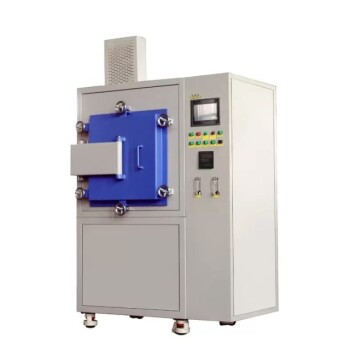At its core, conducting heat treatment in a vacuum provides an unparalleled level of control over the process environment. By removing the atmosphere, you eliminate unwanted chemical reactions like oxidation and decarburization, resulting in a cleaner part with superior mechanical properties and a bright finish. This precision also ensures highly uniform heating and repeatable outcomes.
The fundamental challenge in heat treatment is managing the interaction between a hot metal surface and the surrounding atmosphere. Vacuum heat treatment solves this by removing the atmosphere entirely, preserving the material's integrity and enabling a level of process control that is unattainable with conventional methods.
The Core Principle: Removing the Atmosphere
The primary advantage of a vacuum furnace is what it removes: reactive gases. This seemingly simple act has profound consequences for the quality of the finished part.
Preventing Oxidation and Contamination
In a conventional furnace, oxygen in the air reacts with the hot metal surface, forming an oxide layer, or scale.
A vacuum environment removes virtually all oxygen, preventing this reaction. This ensures the part's surface remains free from contamination and oxide layers that can be difficult and costly to remove.
Eliminating Decarburization
Decarburization is the loss of carbon from the surface of steel at high temperatures. This softens the surface, reducing wear resistance and fatigue life.
Because a vacuum removes the gases that react with carbon, it effectively prevents decarburization. This maintains the material's intended chemical composition and ensures the surface achieves its specified hardness.
Achieving a Bright, Clean Finish
The direct result of preventing oxidation and other surface reactions is an exceptionally clean and bright part.
Parts emerge from a vacuum furnace with a pristine metallic luster, often eliminating the need for post-treatment cleaning processes like sandblasting or chemical pickling.
Unlocking Superior Process Control
Removing the atmosphere also changes the physics of heat transfer, giving engineers and metallurgists a powerful tool for precision manufacturing.
Precision Temperature Uniformity
In a vacuum, heat is transferred primarily through radiation, not convection. This method of heating is exceptionally uniform, bathing the entire part in even energy.
This prevents hot spots and ensures the entire component, including complex geometries, reaches the target temperature consistently. The result is a homogenous microstructure and predictable mechanical properties throughout the part.
High Thermal Efficiency
Vacuum furnaces can offer high thermal efficiency, allowing for rapid heating and, critically, rapid cooling when required.
Processes like high-pressure gas quenching (HPGQ) can be integrated into the cycle, allowing for controlled, rapid cooling that hardens the material without the distortion risk associated with liquid quenching.
Repeatability and Automation
By eliminating the variables of atmospheric composition and pressure, vacuum heat treatment becomes an exceptionally stable and repeatable process.
The highly controlled nature of the process is ideal for automation, ensuring that every part in every batch receives the exact same treatment, which is critical for industries like aerospace and medical devices.
Understanding the Trade-offs
While powerful, vacuum treatment is not the universal solution. Understanding its limitations is key to making an informed decision.
Initial Equipment Cost
Vacuum furnaces are complex systems involving vacuum pumps, sealed chambers, and sophisticated controls. Their initial procurement and installation costs are significantly higher than for conventional atmospheric furnaces.
Process Cycle Time
The need to pump down the chamber to the required vacuum level adds time to the beginning of each cycle. For some high-volume, low-margin parts, this can make it less economical than continuous atmospheric processing.
Material and Process Limitations
Certain materials with high vapor pressures, such as zinc, lead, magnesium, or cadmium, can vaporize (outgas) in a vacuum. This can contaminate the furnace interior and even damage pumping systems.
Making the Right Choice for Your Application
The decision to use vacuum heat treatment depends entirely on your material, your part's end-use, and your quality requirements.
- If your primary focus is surface integrity and fatigue life (e.g., aerospace, medical): Vacuum treatment is essential to create a defect-free surface that maximizes strength and component life.
- If your primary focus is maintaining precise hardness and wear resistance (e.g., high-speed tool steel): Vacuum is the superior method for preventing decarburization and ensuring the material meets its full performance potential.
- If your primary focus is cost-effective bulk treatment of non-critical parts: Traditional atmospheric furnaces may be a more economical choice, provided some surface oxidation and subsequent cleaning are acceptable.
Ultimately, choosing vacuum heat treatment is a decision to prioritize absolute control over the material's final properties.
Summary Table:
| Advantage | Description |
|---|---|
| Prevents Oxidation | Eliminates oxygen to avoid surface scale and contamination. |
| Eliminates Decarburization | Maintains carbon content for hardness and wear resistance. |
| Bright Finish | Produces clean parts without post-treatment cleaning. |
| Uniform Heating | Uses radiation for consistent temperature across complex geometries. |
| High Repeatability | Enables automated, stable processes for critical applications. |
Unlock the full potential of your materials with KINTEK's advanced vacuum furnace solutions. Leveraging exceptional R&D and in-house manufacturing, we provide diverse laboratories with high-temperature furnaces like Muffle, Tube, Rotary, Vacuum & Atmosphere Furnaces, and CVD/PECVD Systems. Our strong deep customization capability ensures precise solutions for your unique experimental needs, enhancing process control and part quality. Contact us today to discuss how we can support your heat treatment requirements!
Related Products
- Vacuum Heat Treat Furnace with Ceramic Fiber Liner
- Vacuum Heat Treat Sintering Furnace with Pressure for Vacuum Sintering
- Molybdenum Vacuum Heat Treat Furnace
- 2200 ℃ Tungsten Vacuum Heat Treat and Sintering Furnace
- 2200 ℃ Graphite Vacuum Heat Treat Furnace
People Also Ask
- How does vacuum heat treatment enhance product quality? Achieve Superior Material Integrity and Performance
- Where are vacuum furnaces used? Critical Applications in Aerospace, Medical, and Electronics
- What is the heat treatment in a vacuum furnace? Achieve Superior Metallurgical Properties
- What is a vacuum furnace used for? Achieve Purity and Precision in High-Temp Processing
- What temperatures are typically used in vacuum hardening? Achieve Precise Hardening for Your Steel Alloys



















